Many teams sometimes resort to the short corner once in a while, but it seems from the pre-season matches that it has become a very popular new trend in corners. As we saw in pre-season matches, Man City used it a lot and scored a goal from a short corner against Bayern Munich. West Ham United also scored a goal against Tottenham from a short corner, and many teams have become more reliant on the short corner than before.
After the tremendous development in defending against corners and the diversity of defensive systems between man-marking, zonal marking and the hybrid system to increase the security of dangerous areas inside the box, the short corner becomes a surprising and practical option that makes the matter look like a chess game because the defending team cannot afford to achieve a numerical advantage inside and outside the box at the same time.
Following the previous logic, when the attacking team increases the numerical advantage in the short corner area and the rebound zone, the defending team can’t start the defence with the same density, leaving few defenders inside the box in the most dangerous areas.
Thus, most teams wait until the short corner has been played, and some players start to go to help in facing the numerical advantage of the attacking team in that area. From here, there are many questions, the most important of which are how many players will face the short corner, what are their initial positions, what distance they cover to go there, and when they will arrive to meet the short corner.
What preceded is the first stage of the short corner, and there is a second stage, which is after getting the ball in the short corner area, what will we do to face the defenders that leave their initial positions and advance forward, forming a line, or keeping the man-marking defending system.
In this tactical analysis, we will talk about the tactics of attacking short corners, and we will talk about the defensive tactics to face the short corner in the next article, part two, which will be a set-piece analysis of the short corner in the defensive phase.
Numerical superiority
In this idea, the attacking team tries to achieve numerical superiority around the short-option area. In the first photo, when the short pass is played, in green, the yellow player, a zonal defender against normal crosses, pushes up to help the short-option defender in red, preventing a 2v1 situation. He arrives in good time, as shown in the second photo, so the situation is an equivalent 2v2 situation.
In the third photo, the plan is clear by using the red player, who acts as he stays at the back for the counterattack at first, to achieve numerical superiority to make a 3v2 situation. As shown in the fourth photo, he gets the ball in an excellent area to play the cross.
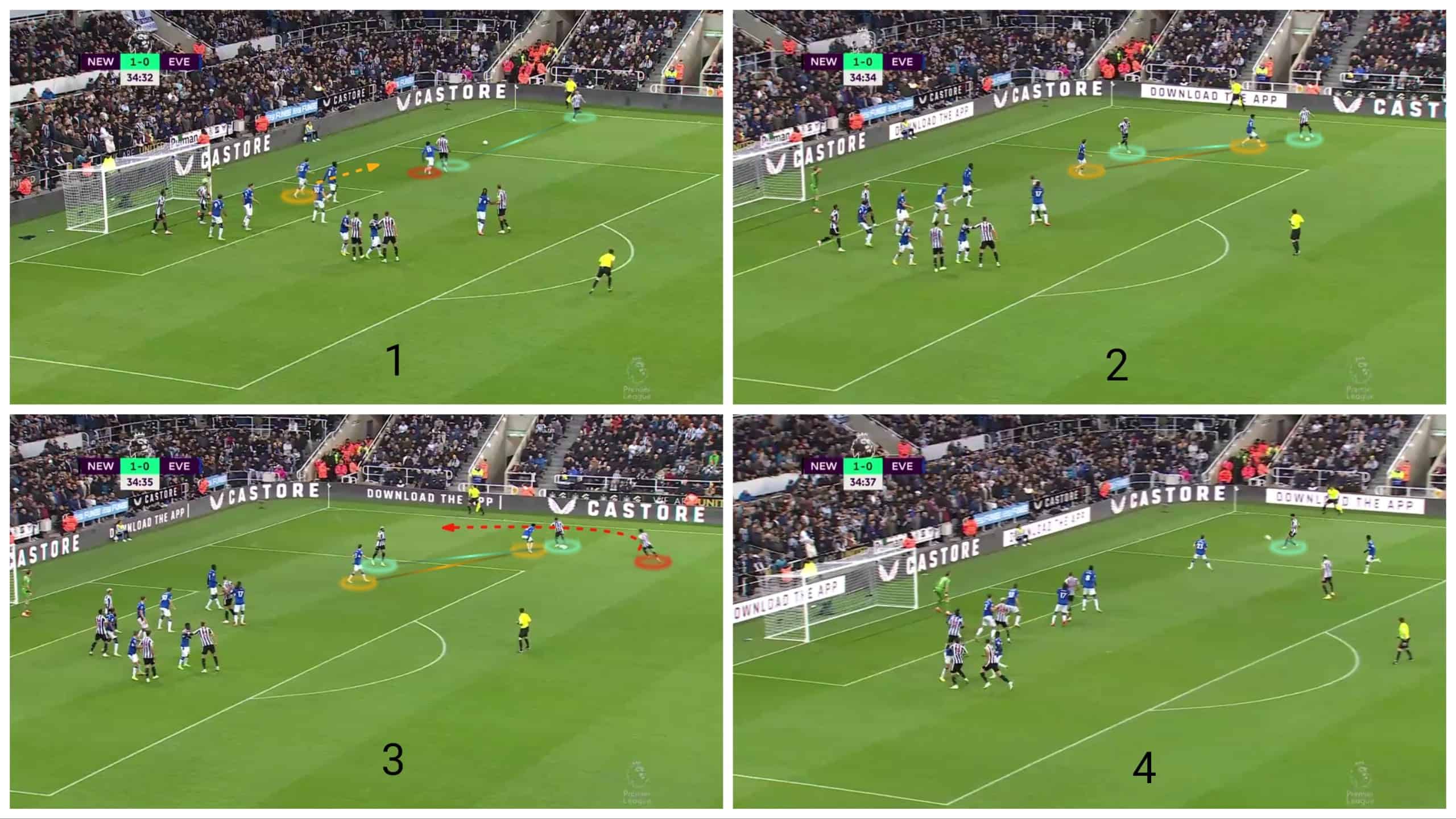
In the case below, the third player, in green, is used to fix the opponent’s player who is responsible for supporting the short-option defender, in yellow, so he can’t help him leaving him in a 2v1 situation.
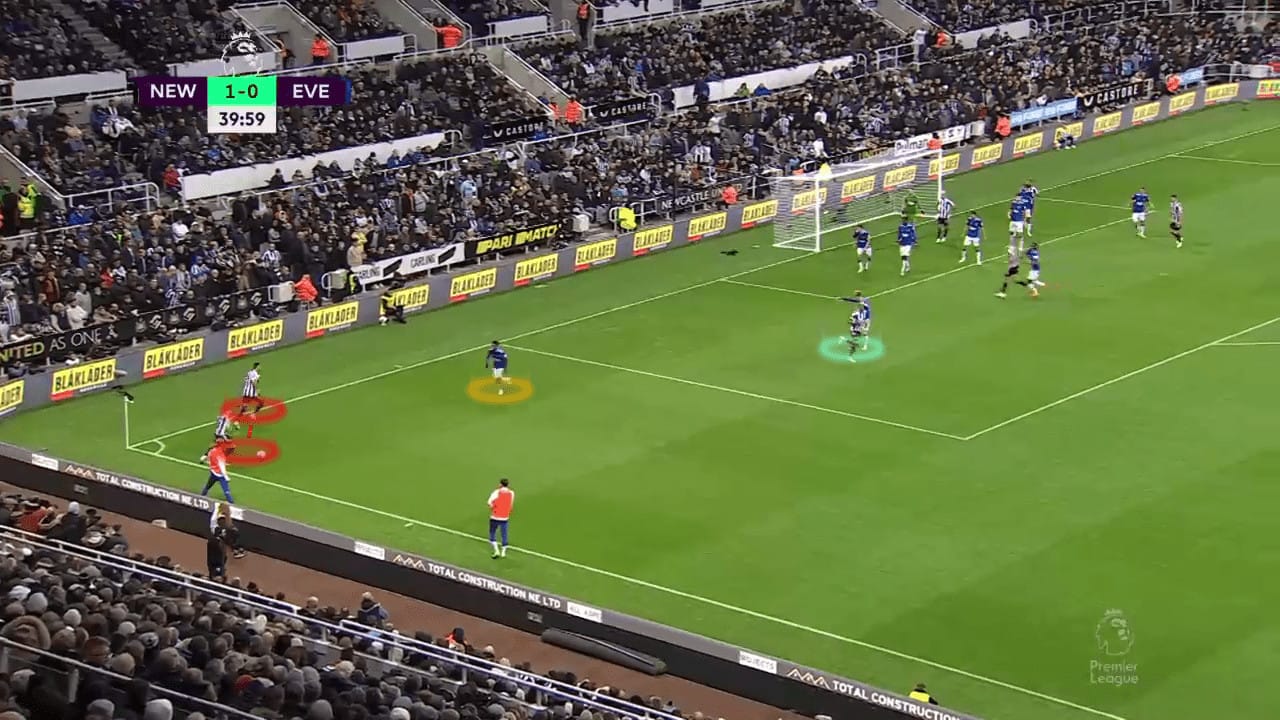
Here, it is another example of a 3v2 situation, but with a different idea. When Arsenal visited Villa Park in February, Oleksandr Zinchenko scored a fantastic goal using this idea. In the first photo, Aston Villa defend with two zonal players in the six-yard box, one zonal player, in yellow, with duties to support Philippe Coutinho in a 1v2 situation against Bukayo Saka and Martin Ødegaard, and six man-markers.
In the second photo, when the short corner is played, the player highlighted in green pushes up toward Coutinho, preventing a 1v2 situation, as we explained, but they don’t have a third player to cover the rebound zone, and that makes the two yellow zonal players go to defend Zinchenko’s strike, but it is too late to deal with the danger adequately.
In the third one, Gabriel Magalhães and Eddie Nketiah play an essential role which is called ‘misdirection’ because they provide the greatest aerial threat in Arsenal’s team, which makes Villa’s defenders focus on the far post, making the right side of the goal more empty for Zinchenko’s strike.
In the fourth photo, another thing to note is the position of the three Arsenal players highlighted in green, framing the goal in case the goalkeeper punches the ball out. This also serves another purpose, as it blocks Villa’s defenders, preventing them from getting out to Zinchenko.
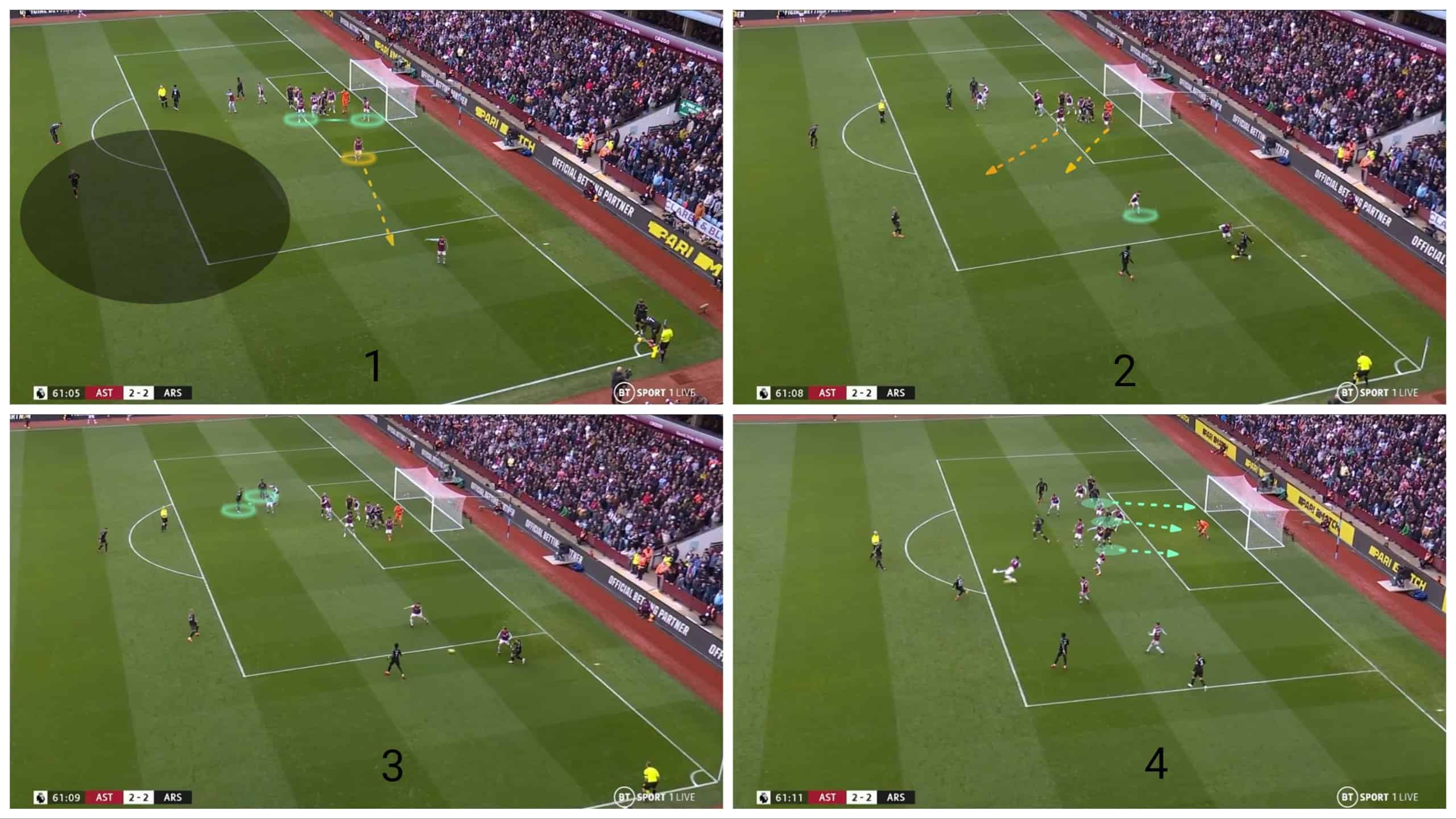
Here, The Hammers have two players in green to face the short option and a player in yellow to cover the rebound zone, and that sounds good, but Newcastle United don’t have a problem using a fourth player coming suddenly from the back after the first pass, in blue out of the shot.
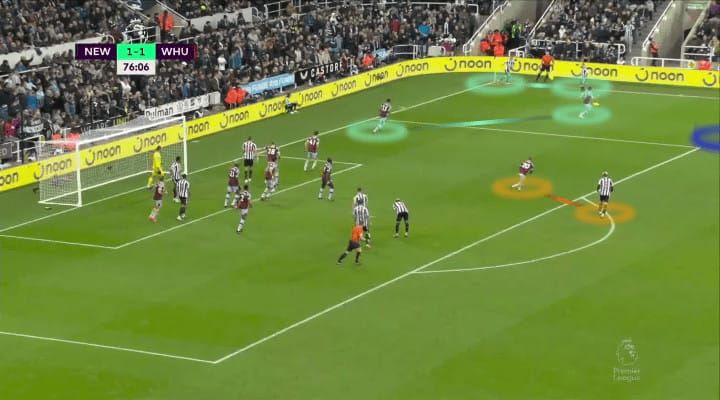
The 4v3 situation is evident here, making it easy for Kieran Trippier to play the cross from a good area, and we will explain the next stage of the short corners later, as we said.
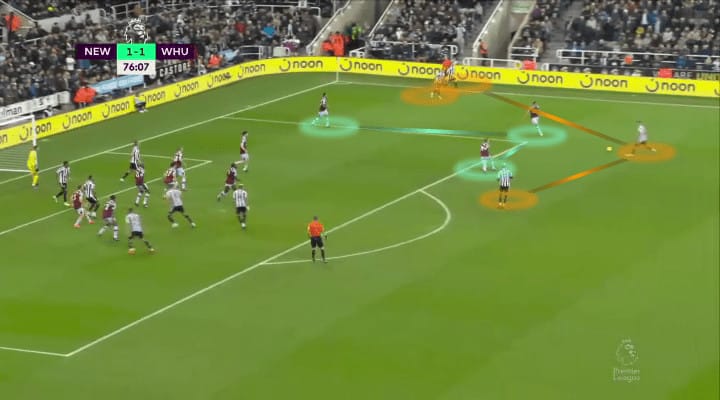
Dynamic superiority
As we said in the introduction, the timing is also important, not only the numerical superiority. In the first photo, teams usually start to defend the short corner with one player at first, in green, to make it safer inside the box against the direct cross, so the initial position for the second defender, in blue, is essential.
In the second photo, he comes to help but so late, because of his initial position, that Tripper can play the cross, so you can guess that it is absolutely wrong and the right thing is to start to move early or start with two players against the short option, as shown in the third photo.
It is like a chess game because the green player moves early from his initial position as a zonal defender on the near post leaving the red player alone there, and it is a trap to play the cross directly to the yellow-arrowed player on the near post. As shown in the fourth photo, he gets the ball, and the result is a goal.
Generally, it is a difficult decision to go early or late for the second defender who comes to help, especially when the attacking short option is too close to the taker or, in the case of two takers, so it attracts the defender to help. The defensive solution for this problem is making defenders have answers for all those questions by the coach or set-piece analyst, which we will discuss in the following article.
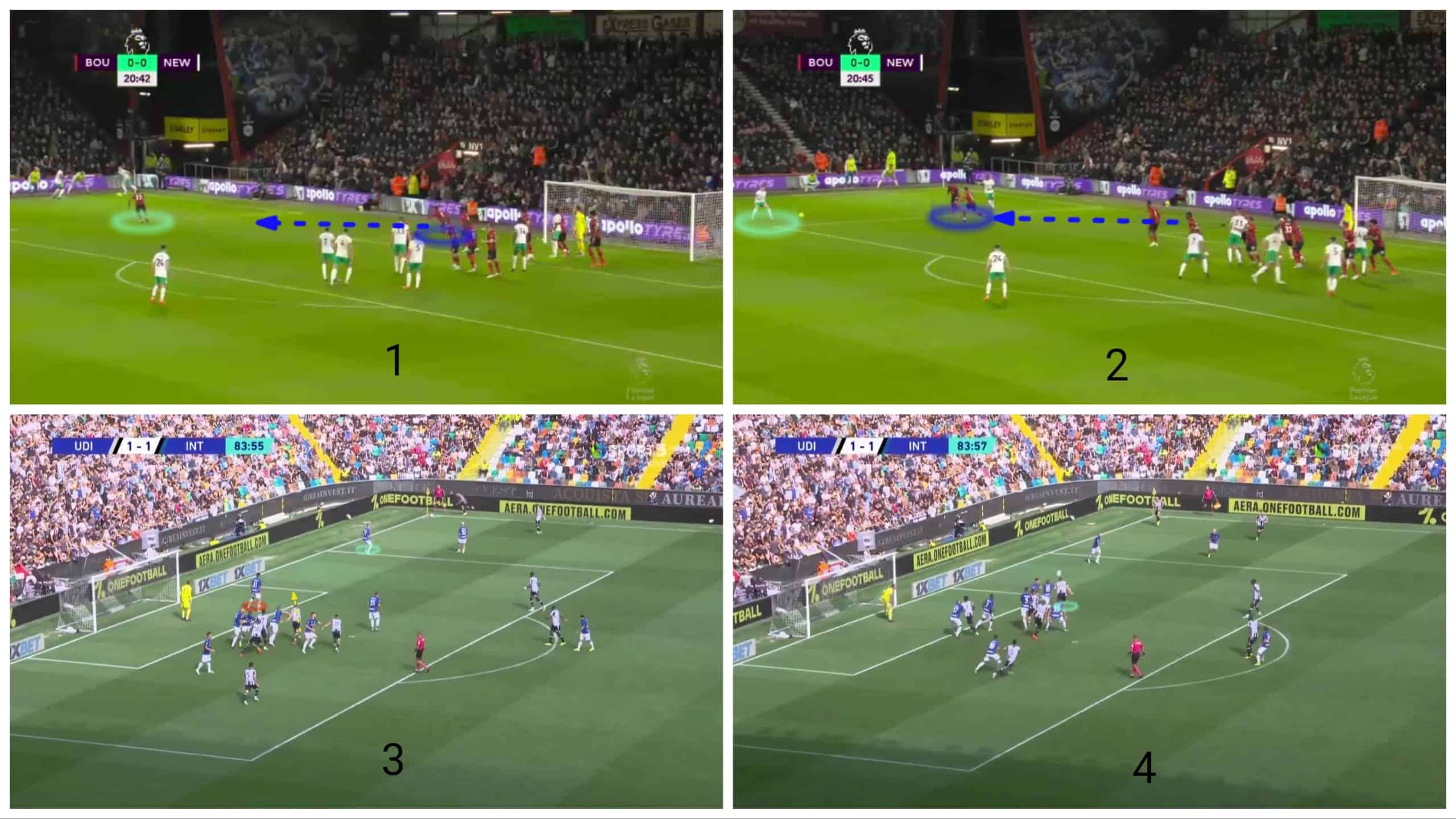
Here, we have another dynamic trick: to start without a short-option attacker, as shown in the first photo, so that the defending team stays in the box. A player in green comes from the box suddenly to receive the short pass, then passes it back to the taker, who has a very large area to play the cross from a nearer position, as shown in the second photo.
The same idea is also used in the third and fourth photos, but with a rebound player in green, who moves quickly to the short-pass area after pretending that he secures the rebound zone.
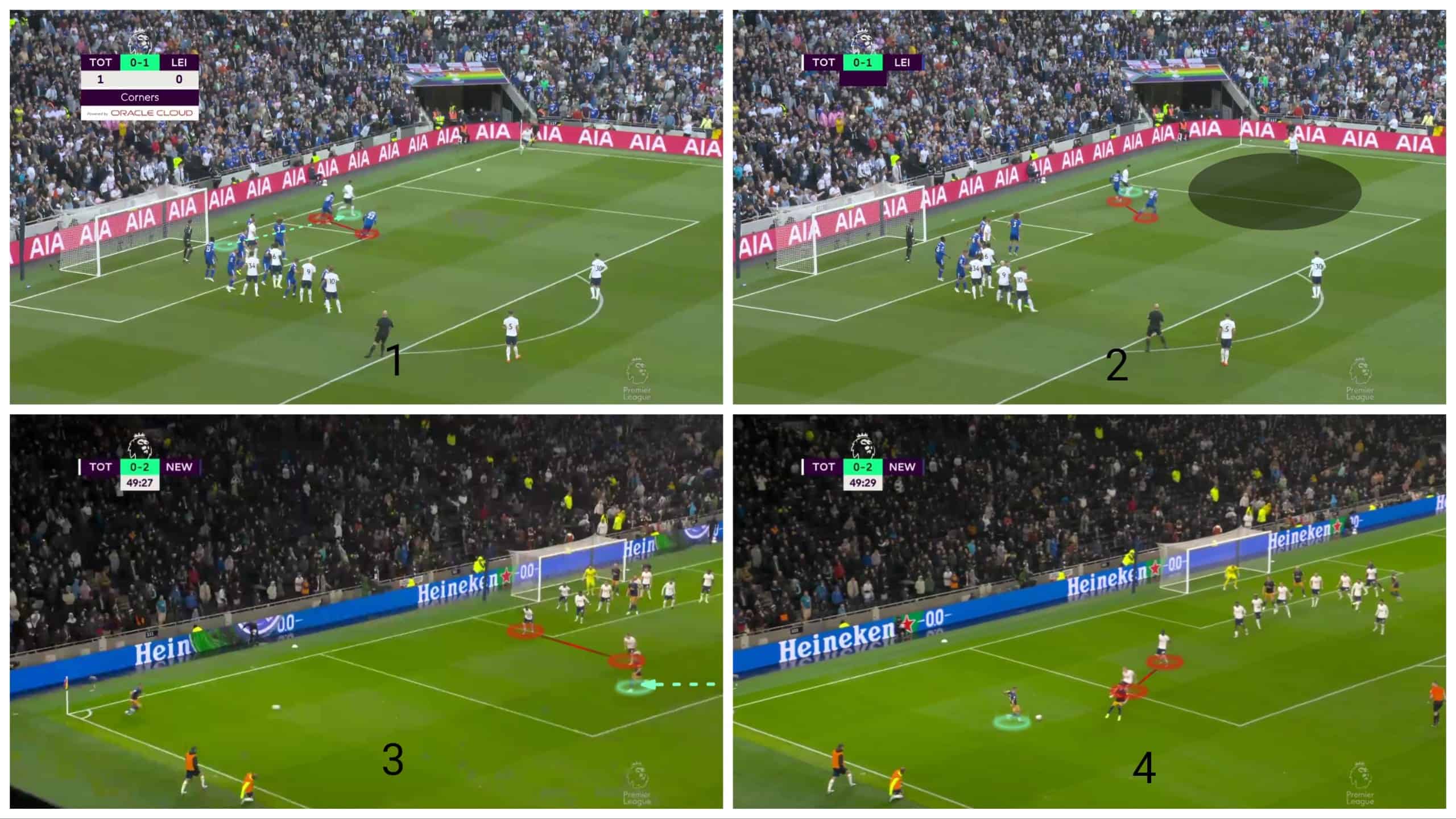
Man City are brilliant at achieving dynamic superiority by using rotations between three or four players.
In the first photo, it is a 3v3 situation, and we will discuss if this third player is responsible for pushing up to help and if he is the right choice in the defending piece. In the second photo, the third attacker gets the ball while the defender is still far, so, in the third photo, he has time for an excellent pass in green, but we should say that this isn’t the problem because it is not a direct threat. The trick is Phil Foden’s yellow movement before the ball reaches the third attacker. At the same time, the defender responsible for him has an orientation problem tracking him and the ball simultaneously in blue.
Another important trick is overloading the far post, in black, to make the space larger for 3v3 rotations exploiting the most skilful three attackers, which is also a qualitative superiority. In the fourth photo, Foden kicks the ball while the four yellow players are framing the goal to get the second ball, and the result is a goal.
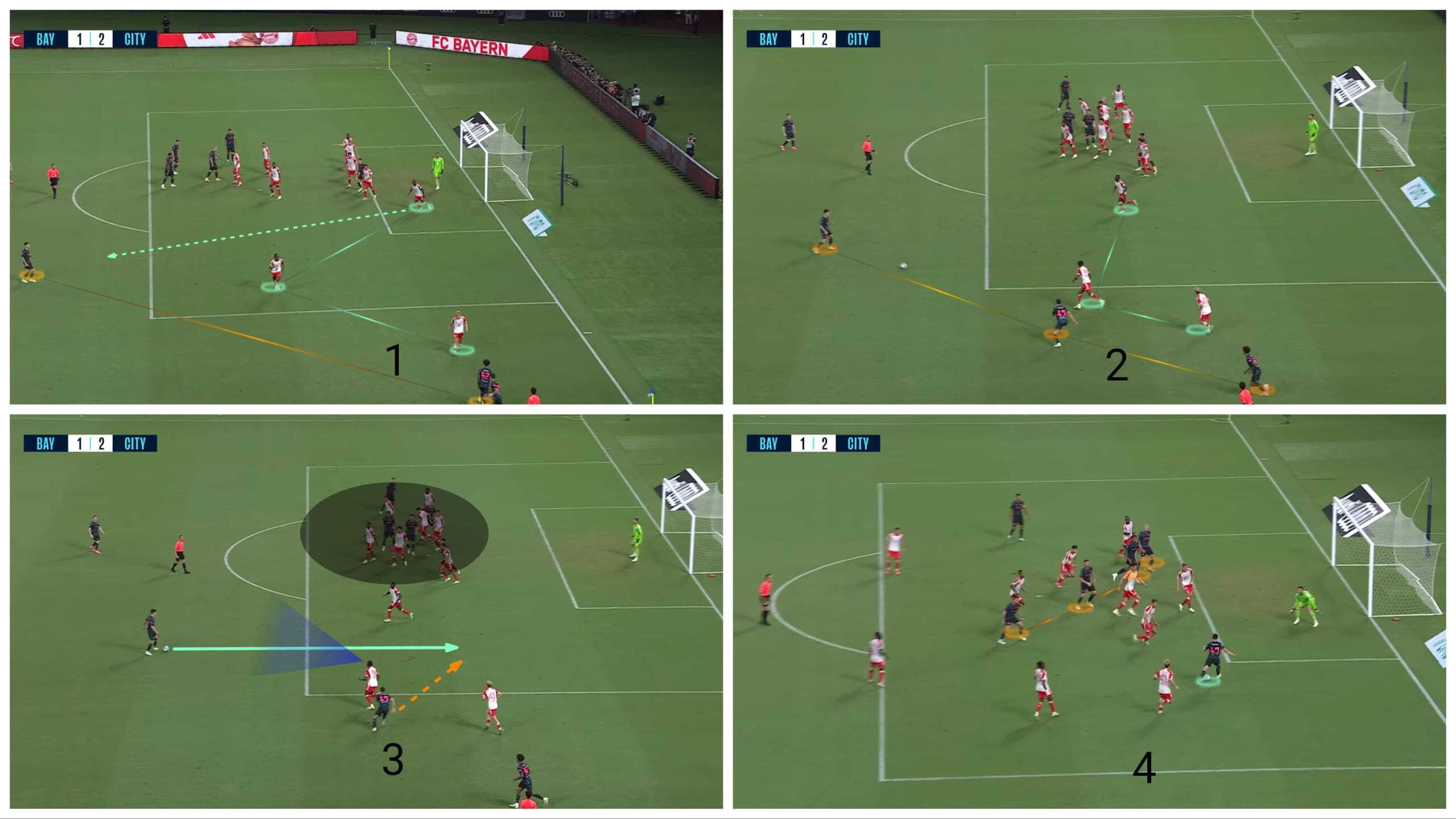
Overlapping is also one of the good rotations. In the first photo, the short option attacker comes from the box to have a good area and time with the ball while the taker moves inside at first, and the rest attackers are on the far post to fix the defence. In the second photo, he receives the ball, but the taker changes his direction, which makes it difficult for the yellow defender to track him. In the third photo, he performs an overlapping run in green, and we should say that the optimum solution is switching between markers by making the nearer player, in yellow, track him, but they should have clear information for that, and the coach or the set-piece analyst must arrange that, as we said.
In the fourth photo, Tripper becomes in a good position, resulting in a goal.
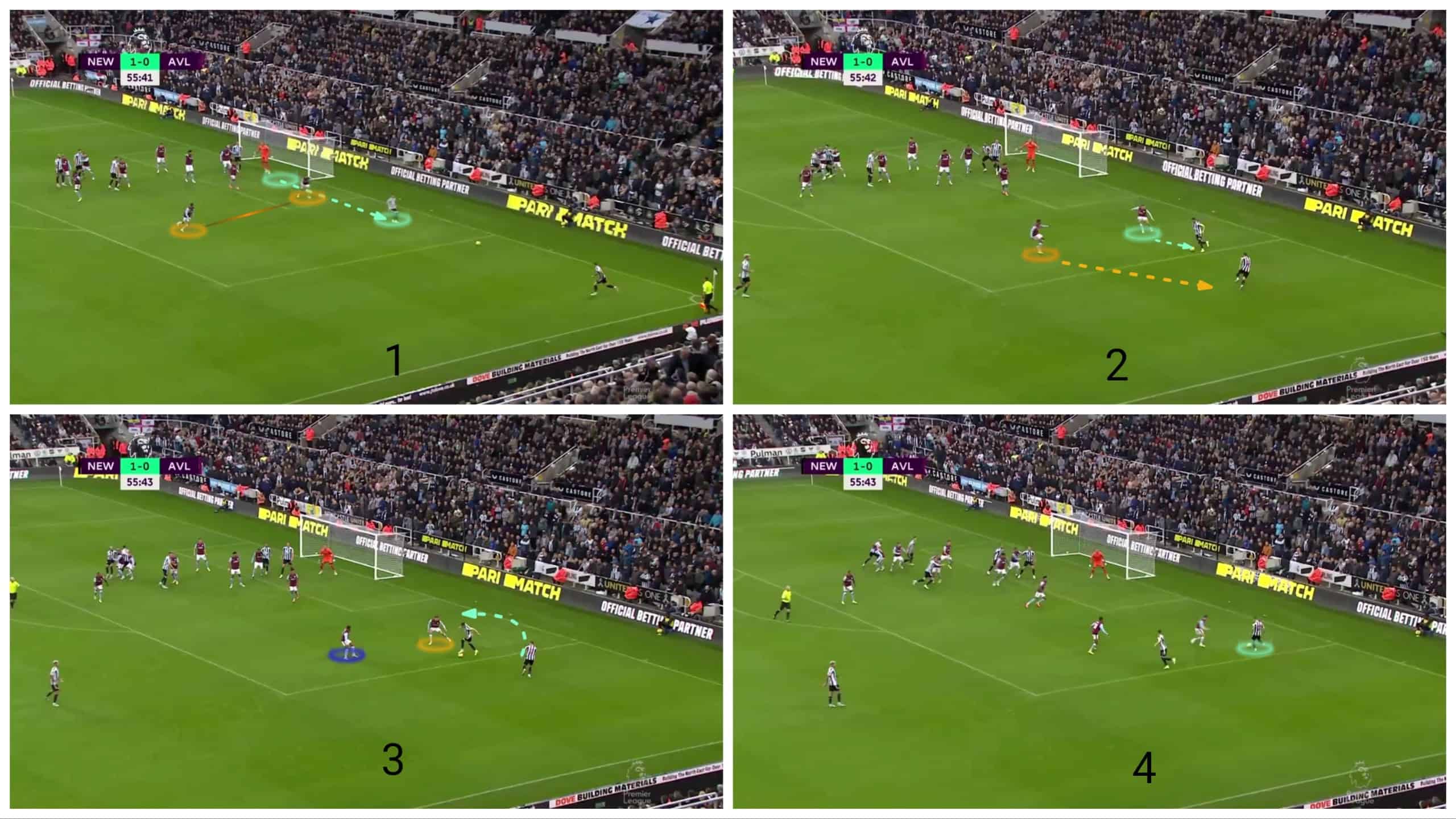
Direct pass to the rebound-player
In the first photo, Crystal Palace defend with two zonal markers highlighted in green, one player in the rebound zone (out of shot) and the remaining seven as man-markers. Newcastle’s trick was the absence of a short corner option and attacking with seven players in the box, so there is a two-versus-one situation for Newcastle in the rebound zone.
In the second photo, there isn’t a short option near the taker to receive a pass, but the taker passes it directly to the rebound zone. Then, the routine begins. The first thing to know is that the targeted zone is on the far post, so the player with the yellow arrow goes to block the zonal player, preventing him from going back.
In the third photo, The target man in the yellow arrow is the second player in the rebound zone who starts moving when the taker passes the ball to the first player in the rebound zone. This routine shocks Crystal Palace’s players, but the green highlighted blocks are important to prevent any player from going to the far post. In the fourth photo, Joelinton strikes the ball wide for a goal kick with two players, highlighted in green, framing the goal.
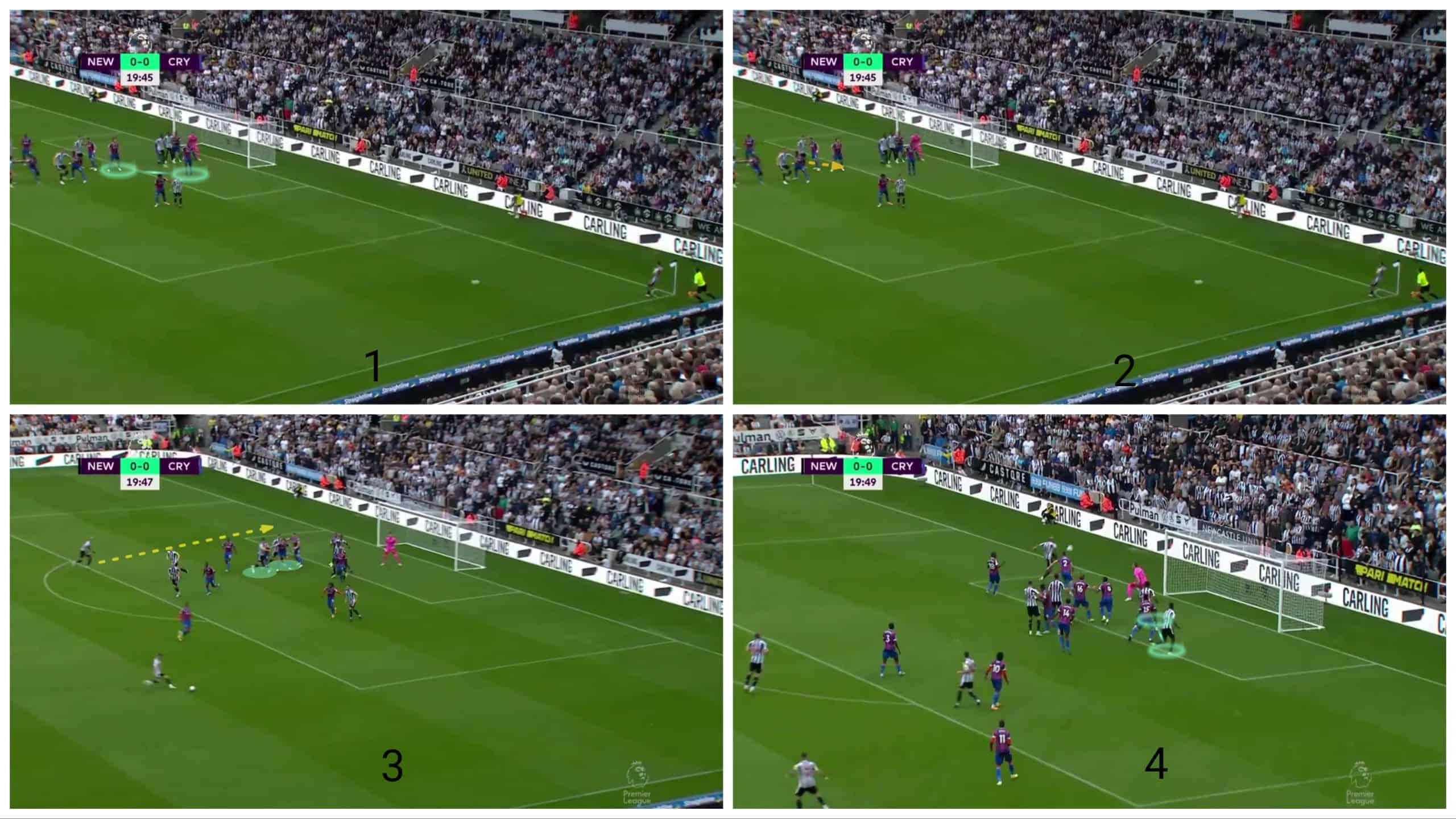
Exploiting problems in reorganising as a line
Here, we will start to talk about famous strategies in the next stage to get the ball into the box after the success in the short and rebound areas.
As mentioned above, the first stage’s idea is the numerical superiority in the short-corner area. In the first photo, we see four players, highlighted in green, against two players, in yellow. The taker passes it directly to the player with the black arrow.
To know why that looks simple, we need to go to the second picture, where Leicester City defend with five zonal players in green, three man-markers in the black area and two players for the short option and the rebound. Brentford have their all ten players in the shot, which is risky, but they achieve numerical superiority around the short and rebound zone. When the player who has the ball passes the ball to his teammate, the player with the yellow arrow stepped back, dragging Leicester’s last zonal player.
In the third photo, the taker, highlighted with a yellow arrow, runs behind Leicester’s line while they try to reorganise their high line. The five zonal players, in green, can stand as a line, but the two short-option players, with black arrows, still try while the taker, with the yellow arrow behind them, runs in their blind side.
The most important note in this routine is Brentford’s four players who still stand in the offside zone, which makes James Maddison late with his marker and worried about this situation, so the corner taker is onside. This trick also helps Brentford’s players to get the cross easily from the taker, as shown in the fourth photo.
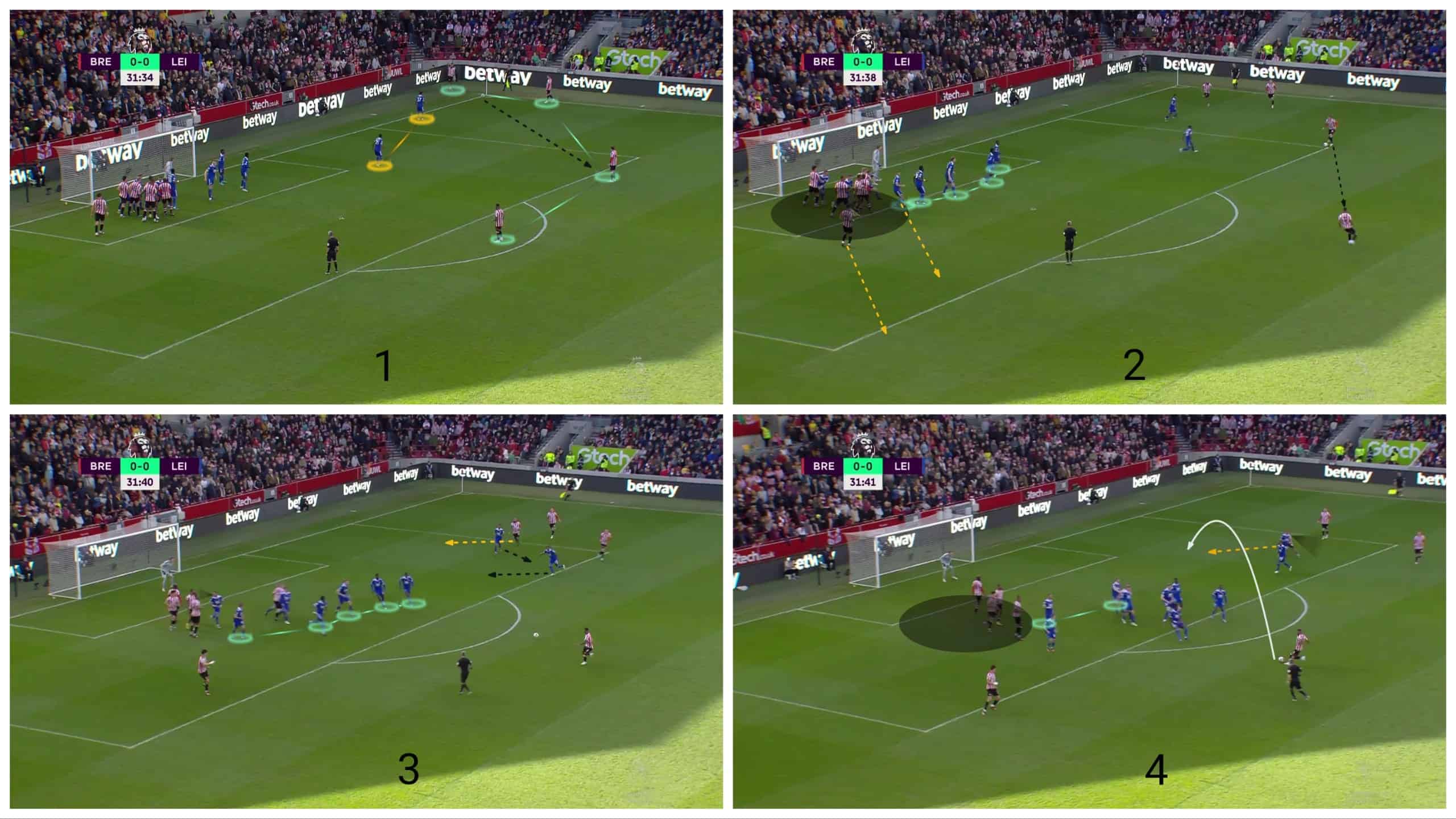
In the first photo, the cross should have been played there, as shown, but the cross is too short, so the defender gets the ball, as shown in the second photo. In the third photo, the player in green receives the ball while Brentford’s attackers are framing the goal. The result is a goal, as shown in the fourth photo.
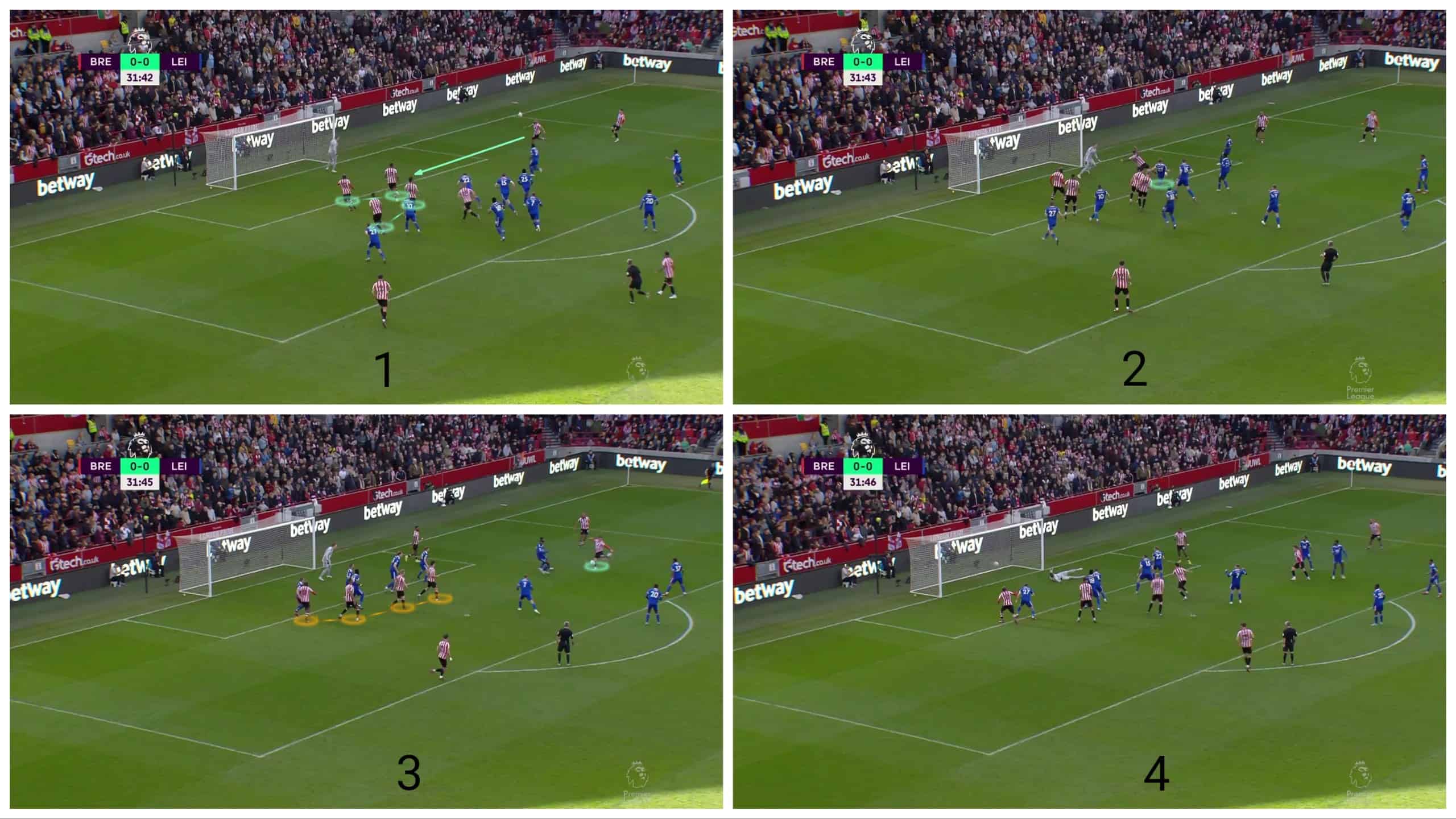
In the first photo, there is a small trick which is the short-option attacker’s pretending that he will pass again to the taker. At the same time, Harry Kane, in green, steps up, but in the second photo, the attacker drops between him and the green defender while they push up to deal with the short corner, as shown in the third photo. The result is a goal, as shown in the fourth photo.
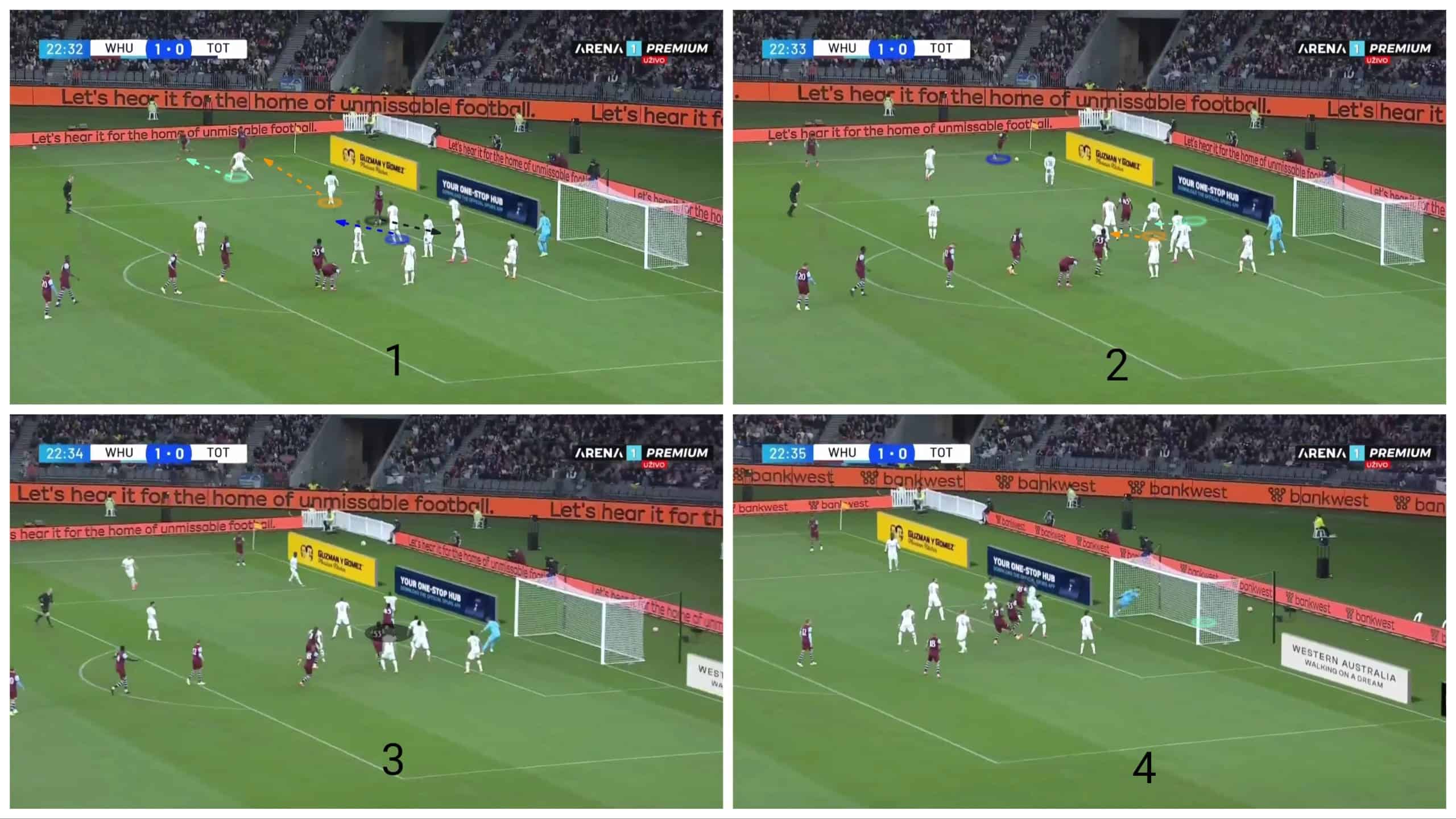
Mismatch and orientation problems on the far post
Tottenham sometimes use short corners to move the organised zonal line, which causes a malfunction in the opponent’s scheme during the reshaping. The target is to empty the far post by dragging the man markers away, which is easy, but the trick is dealing with the zonal players.
In this case, Leicester City defend with four players in the first zonal line, as shown in the first photo. The first one has a duty to defend the short corner if it happens, which is what happens with Perišić. There are only three left in the zonal line.
The second photo shows four players standing in a vertical line which moves in different directions when the short corner is played. With a green arrow, Davies moves to the near post, while Sanchez, with a yellow arrow, moves to stand in front of the last player in the zonal line to take his attention away. Harry Kane and Richarlison move to the far post, highlighted with black arrows.
The third photo shows the position of Sanchez, in green, standing in front of the last player in the zonal line to make the space empty behind him for Kane and Richarlison, highlighted in yellow. Dier and Sanchez are at the near post to drag their markers and two players in the zonal line in a 4v2 situation to make the far post emptier.
There is no longer any problem for Kane and Richarlison except for their two markers. Here, we have two principles: mismatch and orientation. Kane is clever in movement and has the power to win the aerial duels, and this is the mismatch. His marker also has a problem in orientation, as he can’t see the ball and Kane at the same time. Richarlison also has a role in helping him, which is to stand sticking to Kane’s marker to take his attention away and overload the targeted area.
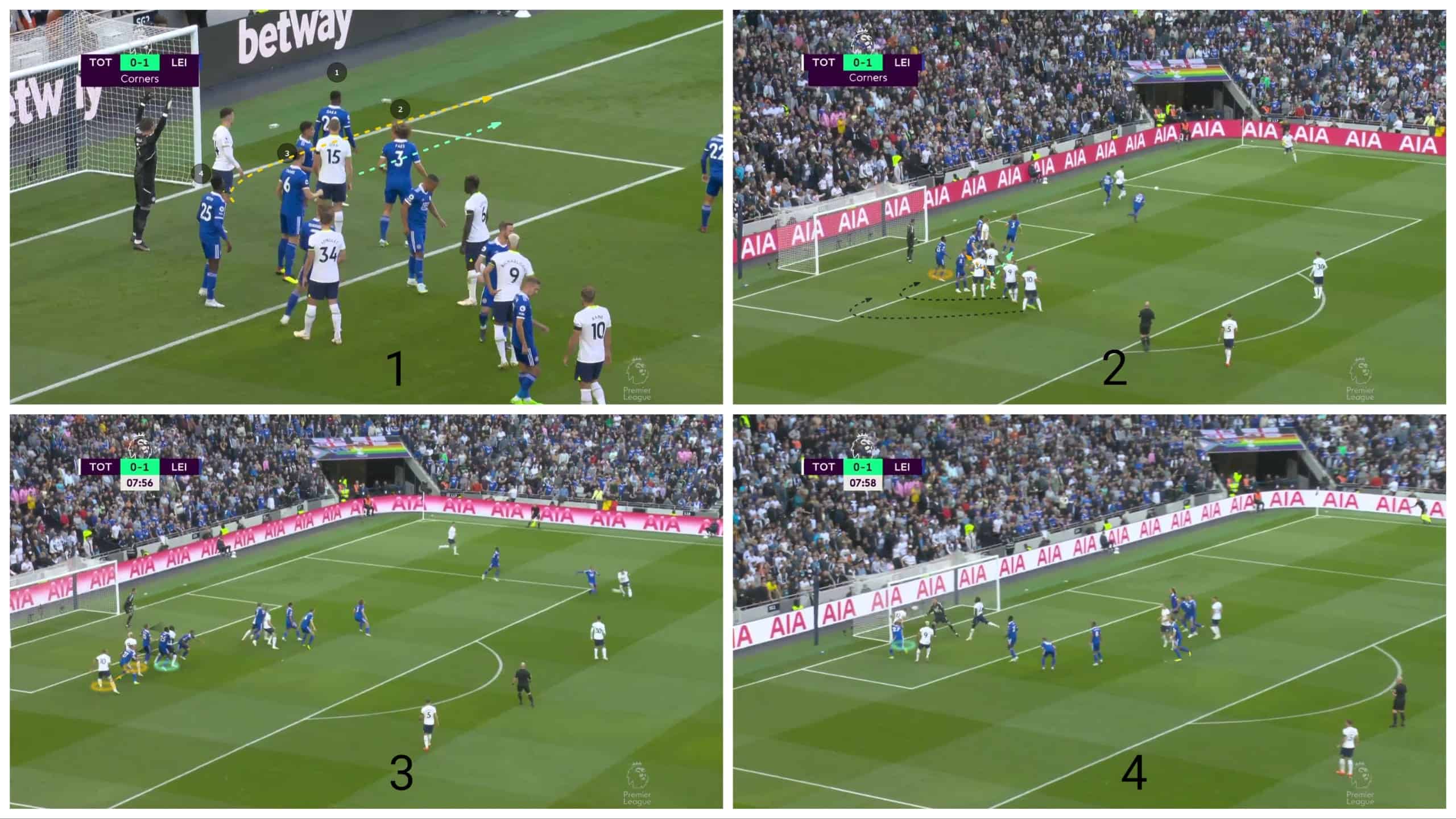
Conclusion
This analysis has explained the different strategies for attacking short corners, showing the different ideas used by many teams and how the matter looks like a chess game.
We will discuss the best ways that are used by teams to defend those ideas in the following article.

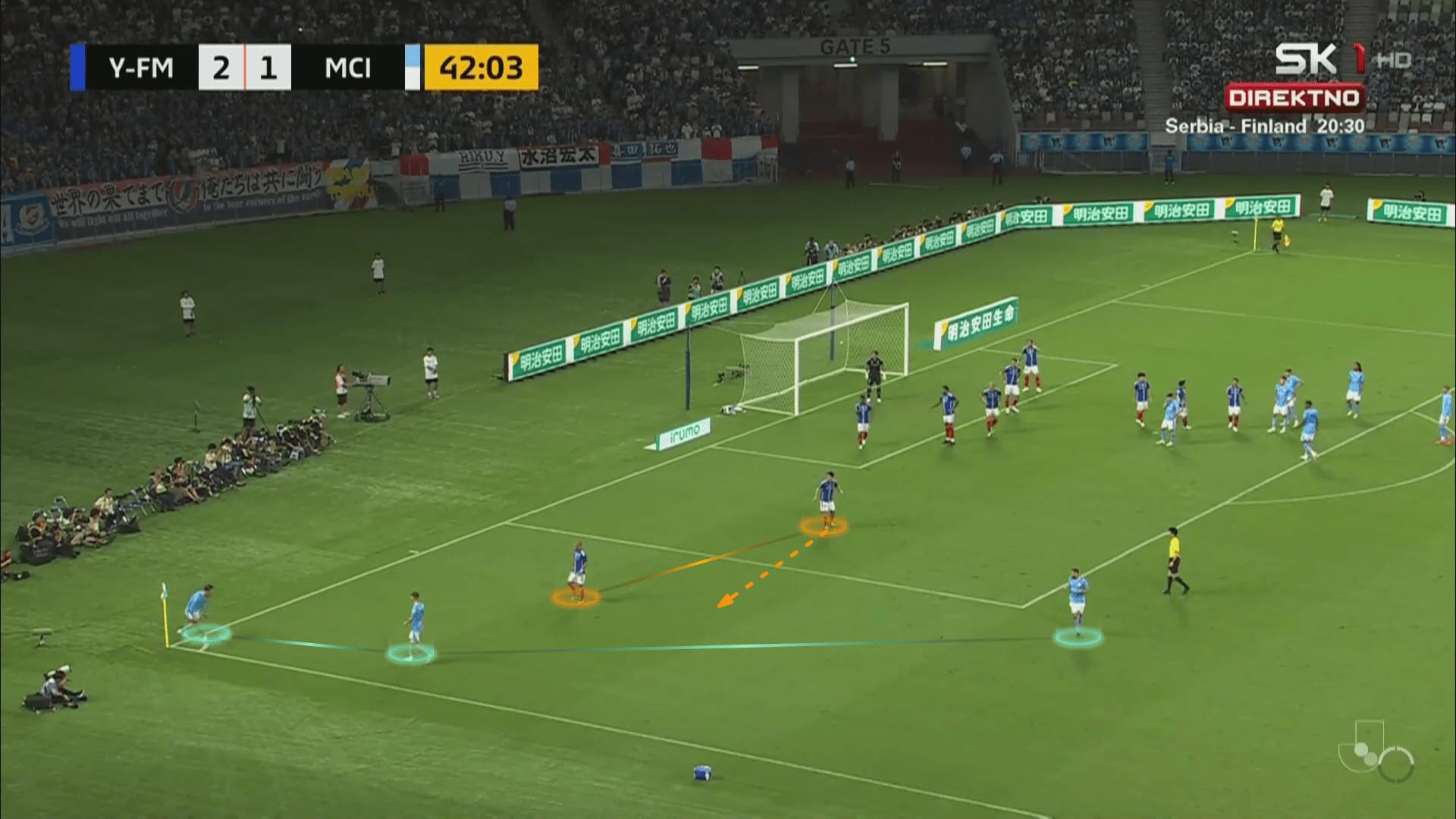




Comments